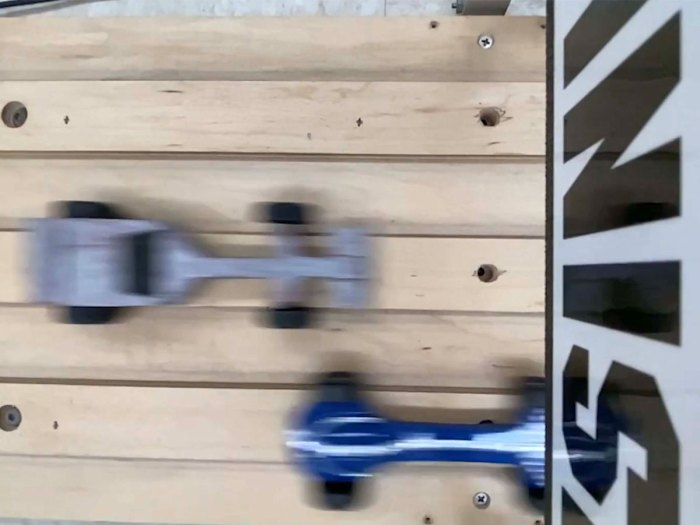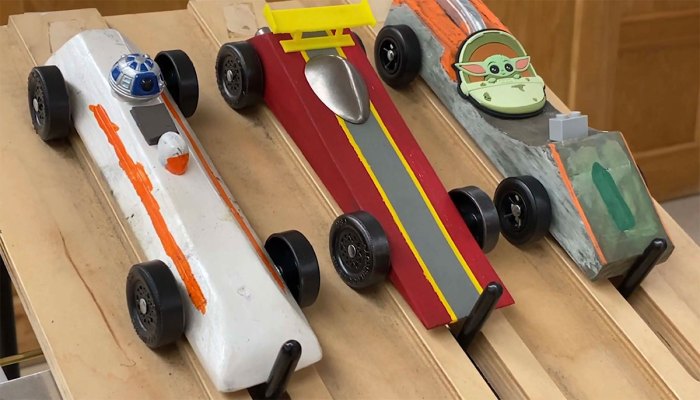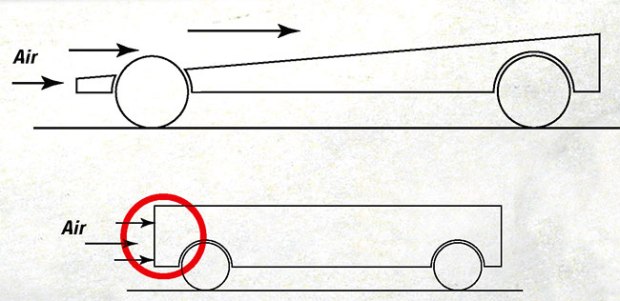How to Make a Fast Pinewood Derby Car

Packs nationwide are gearing up for their annual Pinewood Derby race, and the one thing everyone wants to know: How do I make a fast Pinewood Derby car?
There are a variety of ways to make your Pinewood Derby car go faster. Explore the following tips to optimize your car’s performance and gain a competitive edge in an upcoming race.
BASIC BUILDING GUIDELINES TO GET YOU STARTED
The possibilities are endless when it comes to creating a fast Pinewood Derby car. Before you begin, consider the following general guidelines:
Avoid Pointed Noses: A pointed nose will make it difficult for your car to rest on the pin at the starting gate. It may also cause your Pinewood Derby car to get bumped around when the pin drops, and it can create problems for electronic timing systems at the finish line.
Weight Distribution: Leave ample wood in the rear of the Pinewood Derby car so you can place additional weight there. Concentrate the majority of the weight in the rear for optimal performance.
Maximum Weight: Aim for the maximum allowable weight allowed by your pack’s rules, typically limited to 5 ounces in most races. If your car falls short of this weight, strategically add coins or other weights to meet the requirement.
Clarity in Orientation: Clearly distinguish the front and back of your Pinewood Derby car. In many races, the race officials — not you — will actually place each car on the track. Sometimes the officials put cars on the track backward because they can’t tell which end is which.
Aerodynamic Design: Select a design that facilitates smooth airflow over and around the car body. Pinewood Derby cars with aerodynamic profiles go faster.
Need design ideas? See photo galleries of hundreds of Pinewood Derby cars.

10 STEPS FOR DESIGNING AND BUILDING A FAST PINEWOOD DERBY CAR
You don’t have to strive for the fastest Pinewood Derby car to have fun competing in your Pinewood Derby. But if you and a helpful adult are willing to put in the extra time and effort, these speed tips are for you.
1. Bake the Block: Start your Pinewood Derby car project by baking the wood block at 250 degrees for two hours. This removes moisture and lightens the block, allowing you to place more weight at the rear of the car where you actually want it.

2. Crafting the Design: Outline your Pinewood Derby car on paper, cut it out, and affix it to the wood block.
Remember, a rectangular car is not an aerodynamic design. The most basic aerodynamic design is a simple wedge. If you don’t have time to design a complex car, a wedge will work just fine.
Download a Pinewood Derby car template PDF to help you create your design.
3. Rough Cut the Design: Use a coping saw or enlist the help of a responsible adult with a power tool to cut out the rough shape of your Pinewood Derby car.
4. Shape Your Car: Smooth edges and shape your car using sandpaper. An adult can assist with a rotary tool or other shaping tools.
5. Sand and Paint Creatively: Reduce friction by smoothing the car’s surface and paint an awesome design to make it look great.
How to paint your Pinewood Derby car to give it a shiny finish.
6. Axles and Wheels Alignment: Make sure they are aligned perfectly straight. You can test the alignment of your axles by pushing your car across a smooth floor or table. It should roll smoothly in a straight line.
- Consider a Three-Wheeler: Raise one wheel about 1/16 inch higher so it never actually touches the track. Less friction = more speed. Rules vary from pack to pack, so make sure to check your pack’s Pinewood Derby rules to make sure three wheelers are allowed in your race.
- Extend the Wheelbase: Maximize the distance between front and rear wheels. Again, make sure this is allowed in your race.
Inspect axles closely to make sure they are smooth without ridges or burrs. You can use sandpaper to remove any imperfections.
Learn about polishing Pinewood Derby axles and wheels to reduce friction.
7. Secure Axles with Glue: Glue the axles firmly in their holes to ensure that they stay perfectly placed, but make sure you don’t get glue on your wheels.
8. Strategic Weight Addition: Remember to make your Pinewood Derby car as heavy as the rules allow. In general, it’s best to place weight to the rear of your car because a heavier rear increases speed.
Learn scientific Pinewood Derby speed tips from a former NASA engineer.
9. Use Graphite: Add graphite or another dry lubricant to reduce friction. The less friction between the body and wheel, the better.
10. Have fun! And finally, remember the most important rule of a Pinewood Derby is that it’s supposed to be fun. While you should always strive to do your best, don’t get caught up in winning or having the fastest car. Just enjoy the ride.
Adapted from the book “Pinewood Derby Speed Secrets,” DK Publishing, $12.95 softcover.
I don’t like the idea about raising one wheel to cause less friction…that doesn’t fair. Not to mention it is a four wheel vehicle….no where does it say you can use 3 wheels that I have seen.
none of the rules say you can’t
Before you build, ask. Nothing sucks the life out of a scout or the derby committee more than a car that does not meet the event specifications. While all of those ideas sound GREAT, and they probably work, some of them would violate the rules of your pack. district/ council derby.
so this is still for the boys right?? I mean most 7-13 yo boys can do this alone. Just make sure after you build it give HIM credit so he gets his awards.
imade graphite ports as the car moves down the track it puts more onthe wheels.
really? did it work? how did you do it?
2first places!
cool info
Im trying it right now!
I think this is real is cool because of the ideas
Reuse your already polished axles.
I reccomand using nails instead of axles. We had a practice race 1 week ago and the people who use nails are more likely to win. I used axles but I lost. Hope I helped. Peace out :))
Our Pack 131 isnt allowed to use axles.
That is weird we are aloud
same here, no axles
I am at the wheel installation stage. I’m concerned that the wheels will slide from the outer end of the axle and scrape the body. Is there anything I can do to keep them in place?
This is tricky. Some people advocate angling the nails or axles in the rear slots one degree backward to supposedly help prevent the wheels from making contact with the body. I think this would actually slow the car down because you would have the wheels working against each other when the car rolls down the track. The best and safest way to minimize wheel contact is proper wheel alighnment. Also, pack graphite on the car’s body where the wheels make contact. Washers are not acceptible.